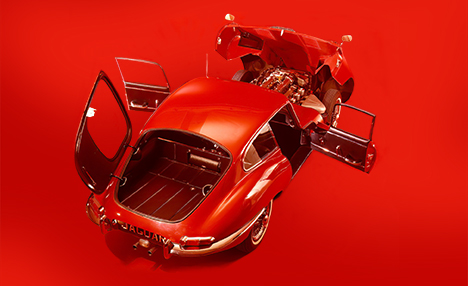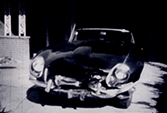From Moss Motoring 1983
The TR story begins in the fall of 1952 with the debut of the TR 1 at the London Motor Show. Only one of this model was built. Based on customer reaction to the prototype and volume production requirements, the first real Triumph, the TR 2, went into production in August 1953. This first model proved to be enormously successful compared to its competitors, and for its time, had quite a reliable engine. The 2’s had a 1991cc engine which had a top speed of 103 mph, did 0—60 in 11.9 seconds and averaged 33 mpg. Road handling and braking still left something to be desired and it was rather noisy, but these aspects would be corrected with subsequent models.
 Sales and production continued to expand, but in 1955 the TR 2 was dropped in favor of the TR 3. Several new features were introduced at this point. An upgraded engine—rated at 95bhp instead of 90, an enlarged front grille and an optional rear seat, just to name a few. The TR 3 was also notable as it was the first British production car to have front disc brakes fitted as standard. 12, 091 were exported (as compared to 5,805 TR 2’s) up to September 1957 when the 3A was introduced. Mechanically, there was no real difference but externally, the nose panel was re-designed and new exterior door handles were added. Sales overseas went well as 56,340 3A’s were sold up to October 1961. The price of this model remained unaltered from 1957 to 1961 which quite possibly could have been an important factor behind why Standard Triumph was in severe financial trouble by 1961 and was taken over by Leyland Motors. Production virtually came to a standstill even though the TR 4 debuted in August 1961. However, it was not received as enthusiastically as was hoped and consequently the TR 3B was produced (March — October 1962) specifically for export to the U.S. 3,331 3B’s sold during this period as it seemed that its classic styling was still highly sought after as compared to the more ‘modern’ TR 4. The initial allotment of 530 3B’s were much the same as the 3A’s, but the remainder had 2,138cc engines with the all-synchro box.
Sales and production continued to expand, but in 1955 the TR 2 was dropped in favor of the TR 3. Several new features were introduced at this point. An upgraded engine—rated at 95bhp instead of 90, an enlarged front grille and an optional rear seat, just to name a few. The TR 3 was also notable as it was the first British production car to have front disc brakes fitted as standard. 12, 091 were exported (as compared to 5,805 TR 2’s) up to September 1957 when the 3A was introduced. Mechanically, there was no real difference but externally, the nose panel was re-designed and new exterior door handles were added. Sales overseas went well as 56,340 3A’s were sold up to October 1961. The price of this model remained unaltered from 1957 to 1961 which quite possibly could have been an important factor behind why Standard Triumph was in severe financial trouble by 1961 and was taken over by Leyland Motors. Production virtually came to a standstill even though the TR 4 debuted in August 1961. However, it was not received as enthusiastically as was hoped and consequently the TR 3B was produced (March — October 1962) specifically for export to the U.S. 3,331 3B’s sold during this period as it seemed that its classic styling was still highly sought after as compared to the more ‘modern’ TR 4. The initial allotment of 530 3B’s were much the same as the 3A’s, but the remainder had 2,138cc engines with the all-synchro box.
Despite all of the preliminary upheaval, the TR 4 with its smoother lines and considerably more refined coachwork, finally went into full production during the fall of 1961. The principal mechanical changes were first, to upgrade the power plant to the 2,138cc unit previously available as an option on the 3A, and also added was the all-synchromesh transmission. The biggest changes, however, were in the body style. Design work was by Triumph’s Italian consultant Giovanni Michelotti. Wind-up windows were now standard, the boot (trunk) space had been enlarged, and optional extras included overdrive, wire wheels, 4.1:1 axle ratio and the “Surrey” hardtop. The TR 4 has often been accurately described as a good interim car as it bridged the gap between classic and modern day sports cars as well as enabling Triumph to market a much more saleable product into the late 60’s and early 70’s.
To keep up with the ever-changing market demands, the TR 4A was heavily re-engineered and considerably more sophisticated. Appearing in January 1965, not much had changed externally except for a revised front grille and bonnet (hood) badge. However, it did have important refinements in the chassis plus the addition of independent rear suspension. Although this was the fastest TR to date—in 12 years—it was losing sales. Only 25,390 4A’s were exported as opposed to 37,661 TR 4’s, so the company unveiled the even beefier TR 5/ TR 250.
While the 4A had a top speed of 110 and 0—60 in .11.4 seconds this all new breed of 6 cylinder cars topped at 120 and did the sprint in 8.8 seconds— overall, quite an improvement! This 2498cc powered model was introduced in the autumn of 1967 as the TR 5 for general export and as the TR 250 in the U.S.A. The 250 model had some special color schemes, plus, regrettably, a ‘de-toxed’ engine with Strom-berg carbs instead of the fuel injection of the 5 to meet the new Federal Emission Control Regulations. This rendered the 250 a bit slower than the its counterpart—the TR 5.
Yet these models were relatively short lived as only 8,484 sold in North America and a mere 2,947 TR 5’s elsewhere. So, it was no real surprise when Triumph hurriedly set out on the task of re-designing it in favor of the TR 6. An almost impossible job from the designer’s point of view as Triumph insisted that the same basic body shell be retained yet a new nose and tail be designed, re-tooled and produced all in the space of 14 months. Michelotti was unable to handle the project at the time so the famous house of Karman accepted the commission. Beyond the fresh, sleek appearance of the body, Stromberg carbs did the best job they could under the circumstances on Federal cars and fuel injection was retained on all other exports. With the exception of the new Laycock ‘J’ series overdrive unit and minor cosmetic additions the TR 6 remained virtually unchanged throughout its lifetime and obviously with good reason—total sales for the 6 peaked at 94,619.

With a story quite similar to the TR 3B/4 saga, the TR 7 was first produced in September 1974. Deliveries of the TR 6 continued until July ’76 from the Coventry works whereas the 7 came out of Liverpool. This radically new wedge design body was principally for the U.S. market, and despite criticism for its styling, sales of over 110,000 make it by far the most popular Triumph to date. With its 1998cc engine, it produced 105 bhp, came with a 5 speed gearbox or optional automatic, had excellent road handling and brakes although rather limited luggage space. A V-8 version, the TR 8, was introduced briefly at the end of the model run, both in closed and convertible forms. Even this, however, was not destined to keep the marque alive. Problems internally at British Leyland and continuing employee disruptions became just too much by the end of 1981 and production was closed down. After all the effort put into creating such a successful line of sports cars, it does indeed seem to have been a great waste, especially for the British motor industry.







'Marque Spotlight: Triumph TR Sports Cars' has no comments
Be the first to comment this post!